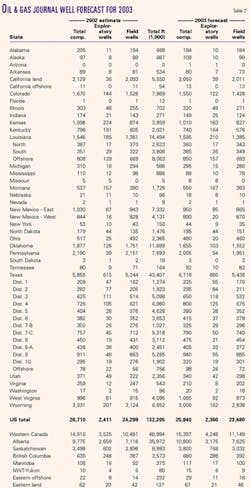A decline is likely in US drilling in 2003 compared with 2002, while a respectable gain is probable in western Canada.
OGJ's early-year forecast of a 3% drop in drilling in the US this year would be welcome next to the 2001-2002 comparison, which is portrayed by a 29% year-to-year decline in the active rig count.
A number of public companies that announce capital spending have indicated that 2003 US outlays will top those of 2002, but OGJ sees lackluster spending overall, at least in the early part of the year.
Other sources have indicated that spending will be higher this year in the rest of the world outside the US and Canada and that non-North American spending increases are one reason for the anticipated decline in the US.
Here are highlights of OGJ's early-year drilling forecast for 2003:
- Operators will drill 25,840 wells in the US, down from an estimated 26,710 wells drilled in 2002.
- All operators will drill 2,360 exploratory wells of all types, down from an estimated 2,411 last year.
- The Baker Hughes count of active rotary rigs will average 780/week this year, down from 830/week in 2002.
- Operators will drill 15,397 wells in western Canada, up from an estimated 14,016 in 2002.
US situation
The American Petroleum Institute estimates that operators drilled 36,812 wells in the US in 2001, the highest since the 1980s (Table 1).
That figure probably will grow slightly in coming months because of the persistent lag between the time operators complete wells in the field and when they report the results to API.
For instance, as of this writing in early January, API statistics showed around 13,000 completions reported in calendar 2002 even though OGJ estimates that more than 26,700 wells were drilled during the year.
OGJ's estimates of exploratory completions for 2002 and 2003 are below API's estimated 2,723 in 2001, which was the highest since 1997.
API now estimates that more than 201 million ft of hole were drilled in 2001, the most since 1985. OGJ's estimate for 2003 is 130 million ft of hole, a figure more in line with the 1990s (Tables 1 and 2).
Large uncertainties for US drilling in 2003 rest with an intense play for gas from coal seams in the Powder River basin.
Legal challenges are likely against federal environmental impact statement record of decision issued in mid-January 2003. Challenges could limit the issuance of drilling permits, and the undrilled prospective area of the basin is more than half federal land.
US hot plays
Steady to lower well completions appear likely in 2003 in several US plays that have involved large numbers of wells in recent years.
Devon Energy Corp., Oklahoma City, announced plans to drill 370 development wells this year for gas in low-permeability Barnett shale in the Fort Worth basin of North Texas. This compares with 350 wells the company drilled there in 2002.
Anadarko Petroleum Corp., which sank 170 wells/year in the East Texas Bossier gas-condensate play in 2001-02, had not announced 2003 plans by this writing. However, the company's drilling in North Louisiana in an extension of the same play has been on the increase, though with much smaller numbers of wells.
The Powder River basin coalbed methane play is the largest contributor of wells in 2002 and 2003 even though OGJ looks for a drilling decline there in 2003.
The Wyoming Oil & Gas Conservation Commission tallied 2,560 wells drilled in that play in 2002 compared with 4,502 in 2001.
The play, which averaged 87 active rigs in 2001, averaged 48 rigs in 2002, and only 25 rigs were running in the play on the last day of 2002, the commission said.
The play is also subject to economic and transportation constraints. Production capacity exceeds transportation capacity out of the basin. Much of the gas reportedly fetches 50-90¢/Mcf at the wellhead after transportation and compression deductions, a severe challenge to operating costs.
The CBM is also caught in an age-old pricing problem. Rocky Mountain gas sold for a majority of 2002 at as much as $2.50/Mcf below the Henry Hub index price, compared with historical discounts of 50¢-$1/Mcf.
Canada's outlook
OGJ's forecast of a nearly 10% increase in drilling in western Canada is more conservative than those of Canadian industry groups.
The OGJ figure could turn out to be conservative, and assessing it is complicated by timing of the budget process. Canadian companies that have been bought by US firms used to have budgets in place several months earlier than their US acquirors. This was due to the need to be operationally ready for the onset of the winter drilling season near the beginning of the fourth quarter of each year.
The Canadian Association of Oilwell Drilling Contractors forecast the drilling of 17,532 wells this year, a 22.4% increase from its 2002 estimate. Petroleum Services Association of Canada's prediction was 16,500 wells, up 9.3%. The estimates date to late October.
CAODC reckoned that 85% of the 663 available drilling rigs will be working in the first quarter of 2003, followed by 33% in the second quarter due to spring ice break-up, 57% in the third quarter, and 50% in the fourth quarter.
Canada's fledgling coalbed methane industry represents an unknown in terms of contribution to the total well count. Only a few hundred wells have been drilled for CBM in Canada, and operators are still assessing reservoir viability of the coals in western Canada and the Maritime Provinces.


